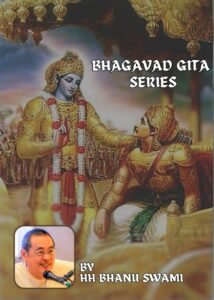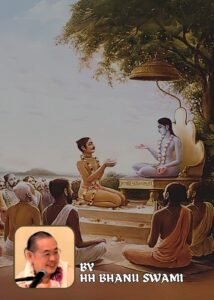Text 13
gopura-dvāra-mārgeṣu
kṛta-kautuka-toraṇām
citra-dhvaja-patākāgrair
antaḥ pratihatātapām
Translation
The city gateway, the household doors and festooned arches along the roads were all nicely decorated with festive signs like plantain trees and mango leaves, all to welcome the Lord. Flags, garlands and painted signs and slogans all combined to shade the sunshine.
Purport
Signs of decoration in special festivals were also collected from the gifts of nature, such as the plantain trees, the mango trees, fruits and flowers. Mango trees, coconut palms and plantain trees are still accepted as auspicious signs. The flags mentioned above were all painted with the picture of either Garuḍa or Hanumān, the two great servitors of the Lord. For devotees, such paintings and decorations are still adored, and the servitor of the master is paid more respects for the satisfaction of the Lord.
HH Bhanu Swami Maharaj :
So, we have a whole series of verses describing the festive nature of the city with all of its decorations. So, in itself, there is nothing philosophical in these descriptions.
And we also see, even today, the same type of decorations are used. So, they put up flags and banners. And they used flowers and banana trees and coconuts. And all of this is to indicate auspiciousness. So, all of this is done in this case because Krishna has arrived. So, Krishna doesn’t need any auspiciousness, he is auspiciousness itself. It’s only by his blessings that everybody in the material world gets auspicious items. But it is similar to making offerings to the Lord.
So, Bhagavad Gita says we should offer a leaf or fruit or flower, the Lord doesn’t need that. Especially because in this material world, we are offering material fruits, material flowers, etc. which are pretty low. But we see in the spiritual world also, the devotees are offering fruits and flowers and water to Krishna, Spiritual things.
But he doesn’t have to eat. He is self-sufficient. Nobody has to eat in the spiritual world.
He doesn’t need flowers or anything for decoration because he is the most beautiful without decorations. In fact, he makes the ornaments more beautiful. But nevertheless, even in the spiritual world, they are offering things to the Lord.
And just as here, they are decorating the city. So, in the spiritual world, they are also decorating everything. Not only in Dwaraka in the spiritual world, but even in Vrindavan in the spiritual world, they decorate the place for Krishna.
So, the reason for this is that this is an expression of their affection for Krishna. We see even in Nectar of Instruction among devotees, how do we show affection. So, we exchange things.
We can give food or we can give gifts or we can give knowledge. So, this is the nature of affection, we like to do things and offer things to the Supreme Lord. So, in the material world, we are doing this as a sadhana. But in the spiritual world, they don’t do any sadhana, but they are still doing the same activities. So now we are practicing offering these things to attain Prema. After attaining Prema we do the same activities not because we are trying to attain something higher than Prema but it is an expression of that Prema. So we are also chanting the name of Krishna as a sadhana. By this sadhana we destroy all karmas, we concentrate the mind on Krishna, we develop bhakti and then we attain Prema.
So, chanting the name of Krishna is also an offering to Krishna. We see here, not chanting the name, but there are verses of glorification of Krishna, that is an offering to Krishna. We can also verses but simpler, simply to chant Krishna’s name.
But of course, even more important than that is the name of Krishna is even more powerful than all of the verses we can chant. So at this point, chanting the name is a means by which we get Prema.
But in the spiritual world, they’re also doing kirtan, also chanting Krishna’s name. So we can ask, well, the whole purpose of chanting is to get Prema. If you got Prema, why do you have to chant anymore? So the answer is yes, chanting the name is a sadhana, but also it’s not a sadhana, it is sadhya, it is part of Prema itself.
So as part of Prema, the devotees in Vrindavan are chanting Krishna’s name. This is an expression of their love for Krishna. So we see, in the Damodar pastime, before Krishna broke the pot, mother Yasoda was churning the yogurt.
And what was she doing? She was chanting the pastimes of Krishna. And by doing so, she could remember Krishna more. So all of these actions are types of devotional service.
Now we do it as sadhana to attain Prema and in Prema, those same activities continue. In other words, bhakti is eternal. Other processes are not eternal.
So you do karma yoga and the result is, go to swarga loka. And you go to swarga loka, no more karma yoga. One does jnana yoga to attain liberation. When we get liberation, no more jnana yoga. So the process you follow is given up when you attain the goal. So in college, you study, that’s your sadhana. Goal is, get the degree. Once you get the degree, you stop the study.
So the material things, the sadhana and the goal are different. When you attain the goal, you give up the sadhana but not so with bhakti. Bhakti is the sadhana. Bhakti is also the goal. But we just call it Prema but it’s the same bhakti. So we do more or less the same activities in sadhana as in Prema. So we’ll see many descriptions here of the different devotees in Dwaraka and Vrindavan, etc., doing all sorts of activities so for them, it is not sadhana. But for devotees in the material world, we do similar activities, then it is sadhana. So Mother Yasoda churns the yogurt into butter. And she is doing that so that she can offer butter to Krishna. So in the material world also, we can churn the butter and we can offer it to Krishna. Here, we’re doing it as a sadhana. In the spiritual world, they’re doing it in Prema. They have spiritual bodies and the butter itself is not material, it’s also spiritual. So here in the material world, we’re using material objects and we have material bodies.
Now, of course, there’s a problem in the material world. Everything is, of course, jada, unconscious and temporary and impure. So how can we offer material things which are impure and temporary to Krishna? And how can we offer with a material body which is impure and temporary and imperfect? So logically, impossible. However, Krishna is very merciful. He allows us to use material objects, to use material body, to use material mind, to use material senses. And even though we use these things, the effect is spiritual.
But by doing that sadhana, eventually the senses and the body and the objects become spiritual. That’s the perfection. Now, how does that take place? It takes place because of bhakti.
If I offer the item which is material, with a material body, but I have bhakti, then we get a spiritual effect. So, Krishna’s mercy is expressed through the power of bhakti itself. So, it can somehow transform material things and produce spiritual results.
Of course, to aid in the process, we have rules. And thus, as much as possible, we use pure items. We have to clean everything before we offer it.
So we have clean flowers, clean water, clean fruit, whatever, clean utensils. Of course, we can argue, well, it’s all material anyway, so what’s the use? It’s all impure. But in a relative way, yes, there is impure, impure in the material world. We have this classification. And though everything is impure in the material world, if it is pure and sattvic, it is preferable to something which is rajasic or tamasic. And why is that? Because these things are material, but by the process of bhakti, they get changed.
But if an object is impure materially, tamasic, rajasic, etc., it is more disturbing to the mind. And if it is in the state of sattva, then we have a peaceful mind. And if we have a peaceful mind, we can execute our bhakti more perfectly. So therefore, we have rules for purity, especially in deity worship. However, of course, even sattva guna is material, so it’s a contamination also. However, in the material world, sattva is more favorable for concentrating the mind and doing your spiritual activities.
But the Lord is very merciful. And thus, he also understands that people, especially in Kali Yuga, are not going to be pure. So, he provides a method by which you don’t have to follow all the rules of purity. That is chanting the name of Krishna. It does not require purity to chant. If you want to chant Vedic mantras, you have to be pure, you have to be sattvic. And if you want to offer to the deity, you have to be pure. You have to take a bath, wear clean clothes, offer pure items.
If the purity is not there, the Lord does not accept. But in chanting the name of the Lord, even if there is impurity, the Lord still accepts. So, this is the special mercy of the Lord for the people of Kali Yuga.
So, whether you are pure or impure, still we get a very great effect from the chanting of the name. So, that is why chanting the name is recommended in Kali Yuga. And there is no regard for whether you are in sattva guna or tamo guna or whatever.
So, Mrigari the hunter started out in tamo guna. Ajamila was of course a fallen brahmana, very contaminated in tamo guna. And when he was dying, he was in an impure state.
But he was chanting the name of Narayana. And as a result, the Vishnudutas came. So, the power of the name is very, very special.
And whether it is sattva, raja, tamo guna or whatever, it does not matter. The name will have effect. So, therefore we put more emphasis upon chanting the name and less emphasis upon other processes of bhakti.
But we do not reject other processes. But each process will have its particular rules to follow. And particularly in archana or deity worship, more rules. And thus, not everybody is allowed to worship the deity. So, in that way, it is not practical to recommend deity worship for everybody in Kali Yuga. But what can everyone do? They can chant the name of Krishna.
Q & A
1) Prabhavali the arch used above dieties , does it have any significance or only used for decoration?
So, this we will see in South India. We don’t see it in North India. So, we will see it for like Balaji or other deities. So, there are different traditions that have developed. Of course, they are not unscriptural. They have some scriptural backing also. But different sampradayas, different traditions will follow different rules of scripture.
Even among Vaishnavas, usually they will choose one scripture to follow, one pancharatra. And another group will choose another pancharatra. And the rules will be slightly different.
2)The material mind and Spiritual Krishna both are incompatible, but how then the mind becomes attracted to Krishna. Does this happen by practise that spiritual body awakens and because of that the spiritual mind is attracted to Krishna? It’s not the material mind is attracted to Krishna. Is this understanding right?
So, we have the jiva covered with a gross body and a subtle body. So, bhakti does not originate in the mind or the ahankara or intelligence. It arises in the jiva.
Bhakti is spiritual. So, it takes shelter of a spiritual particle, the jiva. And in Bhava stage, it finally manifests as the internal energy of Krishna, the Samvit and Hladini shakti. But that bhakti which is in the jiva spreads its influence into the mind and the senses. So, at the stage of bhava, then the mind itself becomes completely absorbed in Hladini and Samvit shaktis also because of the atma. So, before that stage of course, bhakti is not so strong.
So, as we are cultivating the bhakti, at the same time we also have to control the mind. Because along with the mind we have the ahankara and they tend to go to material sense objects. But when one reaches Bhava and Prema, it is the opposite. The mind with the ahankara no longer functions and instead everything is permeated with the devotional service, the bhakti.
But eventually we give up that material body with the material mind, the material senses, etc. And all that is left is the spiritual body, the spiritual mind, the spiritual senses.
3)How do we see devotees shifting Sampradayas, is this because of lack of faith, still they remain as devotees anyway ?
So, to take to bhakti is a matter of faith, we may be materialist or mayavadi, whatever, if we change to bhakti it is based upon our faith. That faith also should be coming from the atma or jiva. If it is not coming from the atma or jiva, it is only coming from the mind. Mind is always changeable, so your faith will always change.
So, if a particular person becomes attracted to a particular Vaishnava sampradaya or faith, then there is nothing wrong with that. He is attracted to that particular form of the Lord and that particular practice. But it is all bhakti, it is all for the Supreme Lord.
4) Can the devotees go from Vaikuntha to Goloka by chanting Hare Krishna?
Generally, if a devotee worships Krishna, he would expect to go to Krishna, not to go to Vaikuntha. And the Lord responds to the desires of the devotee. If the devotee wants to go to Goloka, he won’t take him to Vaikuntha instead.
Devotees: Grantharaj Srimad Bhagavatam Ki.. Jai ! Srila Prabhupad Ki.. Jai !! HH Bhanu Swami Maharaj Ki.. Jai !!


